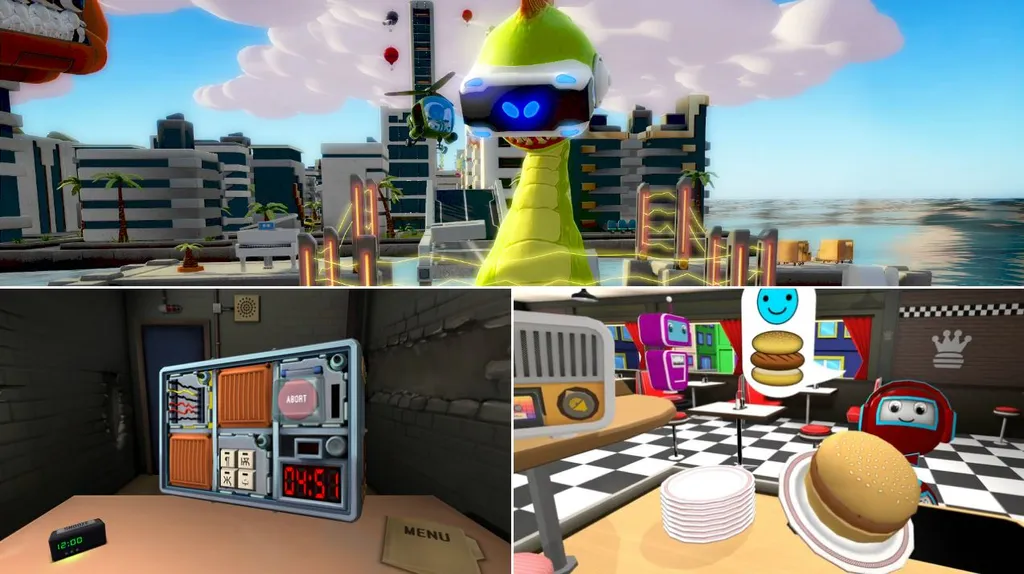The outplayed and overdone narrative is that VR is an inherently isolating experience. The commentary posits that, because you have a hunk of plastic and screen strapped to your face, you couldn’t possible engage in any form of social activity because you’re cut off from those around you. You’re gonna step on a dog, or punch a baby, or something else terrible, and VR is to blame. But that just isn’t the case as local multiplayer VR games are here to disprove the notion through clever use of asynchronous multiplayer mechanics.
They might be rare in VR’s early stages, but there is a secret magic that can only be tapped when you get everyone in the room involved. Playing multiplayer over the internet is great, but enjoying something with everyone else in the room — at the same time — is even better. Here is a concise list of five excellent VR games that let you enjoy local multiplayer with friends and family.
Playroom VR
Platforms: PlayStation VR [PSN Store]
If you got a PlayStation VR, then you should download Playroom VR. There is no excuse. It’s free for everyone and even if you’re by yourself, Robot Rescue is so fun it should be a full game and it’s perfectly playable in single player.
Several of the games are best played with a group of people — some inside the headset, some holding controllers, some just yelling out things from the screen — and it’s sure to yield a few hours of fun for any group. This is one of the best party games we’ve seen in a long time.
Black Hat Cooperative
Platforms: Oculus Rift, HTC Vive, and OSVR [Steam]
We’ve all seen this in a movie before: the secret spy breaks into an enemy compound while the eye in the sky operative, from a remote location, pulls up the map and security blueprints. “Take your next left in this hallway, but make sure to stay on the right wall after you enter,” the remote operative would say. “There’s a guard with his back turned five feet away behind that terminal.”
In Black Hat Cooperative, you get to actually live out that fantasy. One of you puts on the headset and goes into a first-person view as you explore the different levels and the out-of-headset operative feeds you information and directions, as well as hacks into systems for you. Lots of fun for two people.
VR The Diner Duo
Platforms: HTC Vive [Steam]
This game lets us all live out our fantasy of working in the food service industry. The person inside the headset is a chef making burgers and other types of food at a diner while the other person walks the floor taking orders while playing on the PC screen.
The push and pull dynamic between each role is fun and offers enough difference that it actually takes a different set of skills to excel at either of the given jobs. We’d love to see this concept expanded into an even more robust business simulation type of experience.
Ruckus Ridge
Platforms: HTC Vive, Oculus Rift, OSVR [Steam]
If you can round up enough people, Ruckus Ridge might be the most fun party game we’ve seen in VR yet. The person inside the headset has a gun and has to hunt down — don’t worry, it’s silly and bright graphics with fun undertones, not murder — everyone else.
The other people play off of the monitor screen using gamepads while they run around, hide, and evade their headset adversary. With a handful of maps and modes, Ruckus Ridge should be a hit at any VR-related party.
Keep Talking and Nobody Explodes
Platforms: Oculus Rift, HTC Vive, OSVR, PlayStation VR, and Samsung Gear VR [Steam] [Gear VR] [PSN Store]
This is a must-have for any VR headset owner not only because it’s available on every major headset, but because of how purely fun it is. The headset-wearing player is in a room, alone, with a ticking bomb that’s about to explode and has to defuse it before time runs out.
The catch is that the only way to defuse it is by following the instructions that only the non-headset wearing players can see. Either on-screen or via their phone or tablet, they have to relay instructions based on what the bomb defuser sees inside the headset. It’s intense and exciting when the group clicks well together.
[Editor’s Note] – This article was originally published in November of 2016.


























